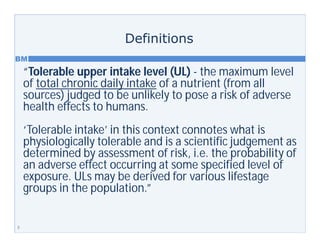Define the Terms Adequate Intake and Tolerable Upper Intake Level
Maximum daily intake unlikely to cause adverse health effects. The term tolerable is chosen because it connotes a level of intake that can with high probability be tolerated biologically by.

Percent Recommended Dietary Allowance Adequate Intake And Tolerable Download Table
Tolerable Upper Intake Level UL.

. Recommended Daily Allowance and the Canadian Recommended Nutrient Intake RNI. The Tolerable Upper Intake Level UL is the highest level of daily nutrient intake that is likely to pose no risk of adverse health effects to almost all individuals in the general population. If the nutrient intake increases above the Tolerable Upper Intake Level or UL the risk of ill-effects on the human body may also increase.
Tolerable upper intake level refers to the maximum amount of a nutrient that a person can. The Scientific Committee on Food SCF and the Food and Nutrition Board FNB have set the Tolerable Upper Intake Level UL for vitamin D at 50 microgday for adolescentsand 50 microgday for infants and children. Following a request from the European Commission the.
Tolerable Upper Intake is the highest level of nutrient intake that your body can tolerate without adverse health effects. Define the terms adequate intake and tolerable upper intake level Adequate intake is the recommended average daily intake level based on estimates of nutrient groups found by experimentation. Established when evidence is insufficient to develop an RDA and is set at a level assumed to ensure nutritional adequacy.
Adequate intake refers to a recommendation thats made when specific data isnt strong enough to make it an RDA but theres enough evidence for general guidelines. Tolerable Upper Intake Level or Upper Limit UL is defined as the highest level of nutrient intake that does not increase the risk of adverse health effects to almost all individuals in the general population. Tolerable Upper Intake Level UL.
See list of nutrients. 6 mgday for children 48 years of age. However tolerable upper intake levels ULs were set.
Adequate intake refers to a recommendation thats made when specific data isnt strong enough to make it an RDA but theres enough evidence for general guidelines. Includes the Recommended Dietary Allowance RDA the Adequate Intake AI the Tolerable Upper Limit TUL and the Estimated Average Intake EAI. The Tolerable Upper Intake Level UL is the maximum level of total chronic intake of a nutrient from all sources judged to be unlikely to pose a risk of adverse health effects in humans.
And Canada used for planning and assessing diets. Adequate Intake AI is the recommended average daily intake level based on observed or experimentally determined approximations or estimates of nutrient intake by a group or groups of apparently healthy people that are assumed to be adequate used when an RDA cannot be determined. As intake increases above the UL the risk of adverse effects increases.
Unless otherwise specified the UL represents total intake from food water and supplements. Lastly the Tolerable Upper Intake Level UL is the highest level of a daily nutrient intake that will most likely present no risk of adverse health effects in almost all individuals in the general population see table. TOLERABLE UPPER INTAKE LEVELS ULs BY LIFE STAGE GROUP Vitamin C -Tocopherol Selenium Life Stage Group mgd Mgd µgd 0 through 6 mo ND ND 45 7 through 12 mo ND ND 60 1 through 3 y 400 200 90 4 through 8 y 650 300 150 9 through 13 y 1200 600 280 14 through 18 y 1800 800 400 19 through 70 y 2000 1000 400 70 y 2000 1000 400.
Has replaced the US. A value based on observed or experimentally determined approximations of nutrient intake by a group or groups of healthy peopleused when an RDA cannot be determined. 17 mgday for adolescents 918 years of age.
Tolerable upper intake levels UL to caution against excessive intake of nutrients like vitamin A that can be harmful in large amounts. Other articles where Tolerable Upper Intake Level is discussed. Functional Foods Ageing and Degenerative Disease 2004.
A set of values for the dietary nutrient intakes of healthy people in the US. This is the highest level of sustained daily nutrient consumption that is considered to be safe for and cause no side effects in 975 of healthy individuals in each life-stage and sex group. The recommended average daily intake level based on observed or experimentally determined approximations or estimates of nutrient intake by a group or groups of apparently healthy people that are assumed to be adequateused when an RDA cannot be determined.
These were 3 mgday for children 13 years of age. And 20 mgday for adults Food and Nutrition Board Institute of Medicine 2001. Tolerable upper intake level refers to the maximum amount of a nutrient that a person can.
The highest level of daily nutrient intake that is likely to pose no risk of adverse health effects to almost all individuals in the general population. A Tolerable Upper Intake Level UL is the highest level of daily nutrient intake that is likely to pose no risk of adverse health effects to almost all individuals in the general population.

Nutrient Risk Assessment And Upper Intake Levels Eu 2105

What Is Tolerable Upper Intake Level Or Upper Limit Ul Ayur Times

Rda 1 Tolerable Upper Intake Levels Ul And Reference Download Table
No comments for "Define the Terms Adequate Intake and Tolerable Upper Intake Level"
Post a Comment